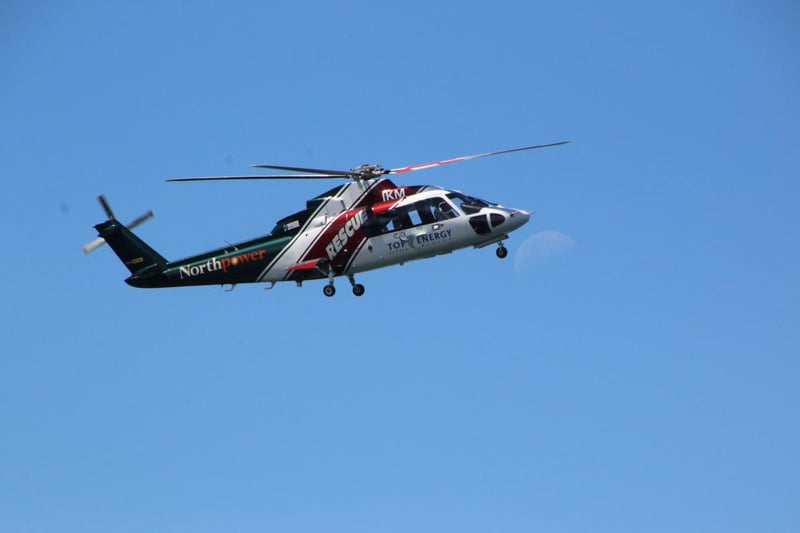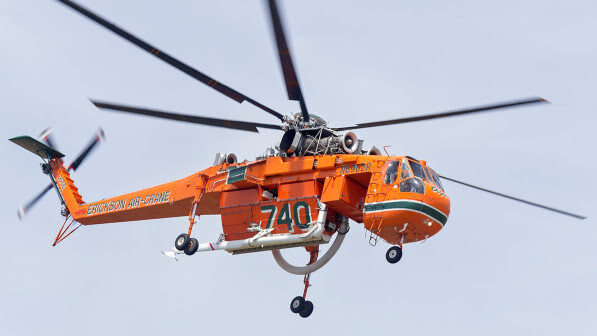Following a wildfire season in the United States in which over 100 people lost their lives, fire agencies are on the hunt for better ways to fight blazes that are now regularly burning over 1 million acres a year and costing billions of dollars to fight.
To keep ahead of the fires and limit the damage they do, agencies are increasingly turning to technology to improve their ability to fight wildfires.
The folks at PumpPod USA are providing a unique system which gives firefighting helicopters, often the backbone of the initial attack, a useful tool to do the job: the HeloPod.
1. Meet the Helopod
2. Environmental Benefits
3. Welcome to the Snag-Free Zone
4. Service for Helicopters Big and Small
5. Looking to the Future
Meet the HeloPod
The HeloPod is an immediately portable next-gen dip tank. From the aspect of the durability and portability, the platform for the HeloPod is based loosely on the design concept of a steel shipping container, like the ones that carry goods overseas on cargo ships.
With this basic concept of durability and portability in mind, the design team at PumpPod USA added the remote fill capacity of up to 800 gpm (3000 lpm), a remote control electronics suite, solar panels to recharge the batteries that power the unit, and communications gear so that helicopters, ground crews, and dispatch centers can communicate with it. Everything is protected by a Lexan shield on top.
“Even though dip tanks have been around for years, the HeloPod has multiple advantages over a Pumpkin tank or a standard bolt together tank."
"Ours is truly portable. It can be here one day, there the next, since it weighs less than 10,000 pounds when empty. The tank is never disassembled and, in fact, requires no assembly by the end-user. It can even be transported with my F-250 and tilt-bed trailer. A flatbed wrecker or Hook Truck [in which a mechanical arm replaces the winch and cable system and a locking system eliminates the need for tie-downs] can do it even easier. It’s a ten-minute load, five minute off-load, and you’re ready to go.”
Its unique structure also allows it to be picked up by a Type 1 Helo for forward deployment in support of air ops or ground ops as a cistern for supply and advanced hose lays.
The idea for the HeloPod came to Walt some years back.
“Our design team and I started designing the HeloPod in 2015. Recently, after the Thomas Fire [which burned 281,893 acres in Santa Barbara and Ventura counties in late 2017], we finally finished the design and built our first prototype.”
The system incorporates multiple cutting-edge communications technologies. “Radio control with DTMF [Dual Tone Multi Frequency] codes is a step further than was possible in the past,” said Walt. “As long as the unit is within service range, the proprietary, built-in Wi-Fi can operate the unit with the addition of our HeloPod App as well.
“This process of R&D helped us develop our production units,” Walt continued.
“Working with an actual shipping container for our prototype proved the need to develop a structure suitable to support the extremes in weight and need for additional durability. Now, with our proprietary engineered platform and electronics technology, they can handle 4,000 - 7,000 gallons (15,000 – 26,500 liters) of water, gel or retardant.”
Their steel tank is coated with a Rhino Liner for additional durability making it much sturdier than a poly tank, which has one additional problem in that it deteriorates quickly with exposure. “Some of the existing metal dip tanks have plastic liners inside, and snorkel pumps punch through those frequently,” Bill Ward, Executive Director at PumpPod USA pointed out.
This all comes at a time when a number of Southern California fire departments are purchasing additional helicopters to enhance their aerial firefighting forces. “We see a paradigm shift in what’s happening with firefighting, especially with the recent addition of Type 1 helicopters, like the FireHawk in the Southern California area,” Walt confirmed.
“The tactics of how agencies, Incident Management Teams and Air Ops Groups utilize the dip tanks are being challenged,” Bill pointed out. “The changes dramatically increase with the addition of Type 1 Helos being brought in to service world-wide. The high capacity of the HeloPod is a real game changer. In addition, because you don’t need any forklifts, or cranes, or specialized equipment, you can move the water source to the fire, reposition it every day or night to keep it close to the fire so that the ‘dip to drop’ time is greatly reduced. And with Southern California fire departments buying these Type 1 helicopters, having a 4,000 - 7,000-gallon tank that can be quickly relocated to any Heli-spot is critical.”

Environmental Benefits
In California environmental concerns are paramount. This applies to aerial firefighting as well.
As Walt explained. “Portable water systems are needed because you can’t even dip in the lakes, like Arrowhead and Big Bear, because it’s against the Clean Water Act due to the fact that you’re dipping from multiple water sources and possibly spreading contaminants and invasive species into drinking and farm water while spitting out kerosene that’s getting into the water.”
As a result, some agencies are beginning to put dip tanks right by water sources.
“One County asked us if it was possible to put a HeloPod right next to a Reservoir so that helicopters can get water to fight wildfires without having to hover over the reservoir,” said Walt.
There’s also a danger to the helicopter crew when hovering over a body of water because if there is a mechanical failure, the crew will have a lot of trouble trying to get out of the helicopter if it plunges into the water. “The survivability of an emergency landing on shore is greater than ditching in water,” said Bill.
“Pilots have told us that they would rather be over our tank and be able to slip to the side and land if there is a problem, rather than being over a body of water where they could drown,” Walt explained. “Even if you had rescue divers suited up, they couldn’t get the crew out in time.”
Welcome to the Snag-Free Zone
One of the major concerns and possible problems with helicopters dipping in bodies of water is that there can be snags just below the surface which helicopter snorkel pumps or Bambi Buckets can get caught on.
“When I was up at a wildfire along Rim of the World Highway [San Bernardino National Forest] I would see helicopters dipping into Green Valley Lake, then flying out with mud streaming and pieces of branches hanging from their pumps from the snags and trees under the water,” Walt recalled.
“I asked one of the pilots about this and he said ‘we’re turnin’ and burnin’, so we just have to put up with it,’ and I thought there’s got to be a better way.”
The focus on eliminating any snags in the HeloPod has produced a unit which has nothing that can catch a bucket or snorkel. There are no edges on the inside or outside, everything is chamfered, even the bolts have mushroom heads eliminating anything to hang up on.
Service for Helicopters Big and Small
With our fill valves allowing up to 800 gpm flow rate, the HeloPod gave one helicopter crew chief a shock. “One County pilot said that he was going to pump our tank dry with his Firehawk, we accepted his challenge and so he tried, but he couldn’t. His Fire Ship only filled at a rate of about 600 gpm, so the water level in the HeloPod never got more than 4” below the top of the tank. We wagered him lunch on that… he still owes us a Double-Double,” Bill added with a smile.
“Type 3 helo pilots voiced concern that, if they have two Type 1’s come in ahead of them on other tanks, their little 5’-6’ snorkel isn’t going to be able to reach the water because the bigger aircraft have lowered the water level so much. But with our tank, the high flow rate equates to the water level always being maintained at a reachable level, about 4” – 12” (10 cm – 25 cm) from the top.”
The HeloPod structure is very robust and can support incidental contact with the skids or landing gear, so a small Type 3 helicopter can actually land on one if it has to.
“One County helicopter actually put a skid on a the HeloPod inadvertently during a training exercise, due to breezy conditions. Unlike a Pumpkin, If a snorkel pump or a Bambi Bucket inadvertently bangs into the HeloPod while the helicopter is performing either an approach or lift-off, neither will take any damage.”
Looking to the Future
Walt and his team are definitely not resting on their laurels. “At our parent company, Think Pod Inc., we anticipate and envision what’s needed. We are creating answers to the question… What’s coming next."
“We have many more innovations, so our product lines will evolve and increase dramatically. We’ve already designed five variations on the standard HeloPod for our clients.”
PumpPod USA has also developed retrofit kits so that Fire Departments can remotely control their existing deployed dip tank(s).
“You can buy a retrofit kit, but the condition of the existing tank will be taken into account due to exposure damage,” Walt cautioned. “Our tanks are coated steel which will last 25-30 years minimum, with limited maintenance required. Typical maintenance is as simple as cleaning the solar panels once a month, which have a service life of about 15 years.”
Other projects are still under wraps, but considering how well the HeloPod is being received, it’s pretty much a certainty that fire agencies are going to like what comes next!
